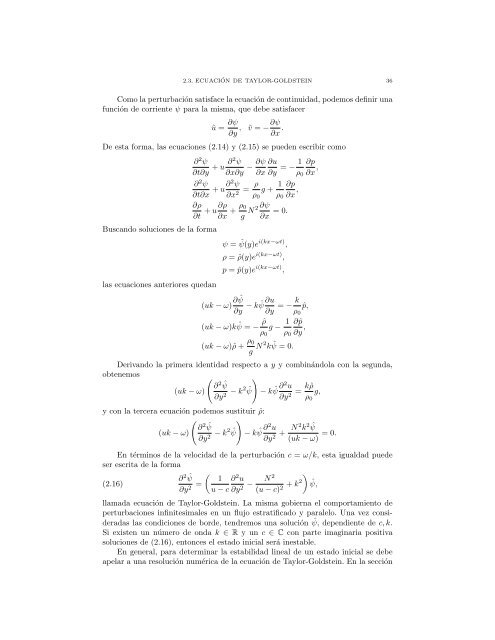Flujo de fluidos estratificados - PreMAT
Flujo de fluidos estratificados - PreMAT
Flujo de fluidos estratificados - PreMAT
You also want an ePaper? Increase the reach of your titles
YUMPU automatically turns print PDFs into web optimized ePapers that Google loves.
2.3. ECUACIÓN DE TAYLOR-GOLDSTEIN 36<br />
Como la perturbación satisface la ecuación <strong>de</strong> continuidad, po<strong>de</strong>mos <strong>de</strong>finir una<br />
función <strong>de</strong> corriente ψ para la misma, que <strong>de</strong>be satisfacer<br />
ũ = ∂ψ<br />
, ˜v = −∂ψ<br />
∂y ∂x .<br />
De esta forma, las ecuaciones (2.14) y (2.15) se pue<strong>de</strong>n escribir como<br />
∂2ψ ∂t∂y + u ∂2ψ ∂ψ ∂u 1 ∂p<br />
− = −<br />
∂x∂y ∂x ∂y ρ0 ∂x ,<br />
∂2ψ ∂t∂x + u∂2 ψ ρ<br />
= g +<br />
∂x2 1 ∂p<br />
∂x ,<br />
∂ρ ∂ρ<br />
+ u<br />
∂t ∂x<br />
Buscando soluciones <strong>de</strong> la forma<br />
las ecuaciones anteriores quedan<br />
ρ0<br />
ρ0<br />
ρ0 2 ∂ψ<br />
+ N = 0.<br />
g ∂x<br />
ψ = ˆ ψ(y)e i(kx−ωt) ,<br />
ρ = ˆρ(y)e i(kx−ωt) ,<br />
p = ˆp(y)e i(kx−ωt) ,<br />
(uk − ω) ∂ ˆ ψ<br />
∂y − k ˆ ψ ∂u k<br />
= − ˆp,<br />
∂y ρ0<br />
(uk − ω)k ˆ ψ = − ˆρ<br />
g − 1 ∂ ˆp<br />
∂y ,<br />
ρ0<br />
ρ0<br />
(uk − ω)ˆρ + ρ0<br />
g N 2 k ˆ ψ = 0.<br />
Derivando la primera i<strong>de</strong>ntidad respecto a y y combinándola con la segunda,<br />
obtenemos<br />
<br />
∂<br />
(uk − ω)<br />
2 ˆ ψ<br />
∂y2 − k2 <br />
ψˆ<br />
− k ˆ ψ ∂2u kˆρ<br />
= g,<br />
∂y2 y con la tercera ecuación po<strong>de</strong>mos sustituir ˆρ:<br />
<br />
∂<br />
(uk − ω)<br />
2 ˆ ψ<br />
∂y2 − k2 <br />
ψˆ<br />
− k ˆ ψ ∂2u ∂y2 + N 2k2 ˆ ψ<br />
= 0.<br />
(uk − ω)<br />
En términos <strong>de</strong> la velocidad <strong>de</strong> la perturbación c = ω/k, esta igualdad pue<strong>de</strong><br />
ser escrita <strong>de</strong> la forma<br />
∂<br />
(2.16)<br />
2 ˆ <br />
ψ 1 ∂<br />
=<br />
∂y2 u − c<br />
2 <br />
2 u N<br />
− + k2 ˆψ,<br />
∂y2 (u − c) 2<br />
llamada ecuación <strong>de</strong> Taylor-Goldstein. La misma gobierna el comportamiento <strong>de</strong><br />
perturbaciones infinitesimales en un flujo estratificado y paralelo. Una vez consi<strong>de</strong>radas<br />
las condiciones <strong>de</strong> bor<strong>de</strong>, tendremos una solución ˆ ψ, <strong>de</strong>pendiente <strong>de</strong> c, k.<br />
Si existen un número <strong>de</strong> onda k ∈ R y un c ∈ C con parte imaginaria positiva<br />
soluciones <strong>de</strong> (2.16), entonces el estado inicial será inestable.<br />
En general, para <strong>de</strong>terminar la estabilidad lineal <strong>de</strong> un estado inicial se <strong>de</strong>be<br />
apelar a una resolución numérica <strong>de</strong> la ecuación <strong>de</strong> Taylor-Goldstein. En la sección<br />
ρ0


